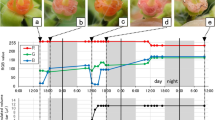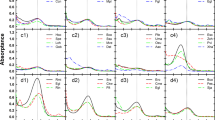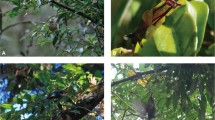Abstract
WHEN the dried petals of Adonis annua L. (Ranunculaceæ) (pheasant's eye) are extracted with light petroleum or methanol comparatively large quantities of a deep orange-red carotenoid are obtained. This pigment had an absorption spectrum (in light petroleum, n-hexane, carbon disulphate and pyridine) very similar to that of astaxanthin1; as the pigment is epiphasic in the 90 per cent aqueous methanol/light petroleum partition test, it would appear to be esterified astaxanthin2. The nature of the pigment was confirmed by saponifying the extract. This hydrolyses the esters and converts the liberated astaxanthin into astacin3 which when the reaction mixture is shaken with ether to extract the unsaponifiable material, collects at the interface as a flocculent orange-red mass. No other known carotenoid behaves in this manner; they are all extractable from a saponification mixture with ether. The flocculent red mass was washed free of alkali and dissolved in dilute hydrochloric acid; as is the case with authentic astacin, the pigment was now extracted from the aqueous phase by ether. The pigment was then purified by chromatography on sugar. Further confirmation of the identification of our pigment with astacin came from various comparisons with authentic astacin (from lobsters); (1) the absorption spectra of the two pigments measured in a number of solvents were identical in position and shape; (2) on co-chromatography on icing sugar using light petroleum containing 2 per cent (v/v) acetone the mixture of the two pigments moved slowly down the column but there was no resolution into two bands; (3) treatment of both pigments with lithium aluminium hydride produces identical pigments (probably 3,4,3′,4′-tetrahydroxy-β-carotene) with absorption spectra indistinguishable from that of β-carotene.
This is a preview of subscription content, access via your institution
Access options
Subscribe to this journal
Receive 51 print issues and online access
$199.00 per year
only $3.90 per issue
Buy this article
- Purchase on Springer Link
- Instant access to full article PDF
Prices may be subject to local taxes which are calculated during checkout
Similar content being viewed by others
References
Goodwin, T. W., ‘Handbook of Plant Analysis’, 2 (1955).
Seybold, A., Sitzgsber. Hdbg, Akad. Wiss., Math.-naturw. Kl. 31–124 (1953–54).
Goodwin, T. W., ‘Comparative Biochemistry of the Carotenoids’ (London: Chapman & Hall, 1952).
Author information
Authors and Affiliations
Rights and permissions
About this article
Cite this article
SEYBOLD, A., GOODWIN, T. Occurrence of Astaxanthin in the Flower Petals of Adonis annua L.. Nature 184, 1714–1715 (1959). https://doi.org/10.1038/1841714a0
Issue Date:
DOI: https://doi.org/10.1038/1841714a0
This article is cited by
-
Genetic engineering of the complete carotenoid pathway towards enhanced astaxanthin formation in Xanthophyllomyces dendrorhous starting from a high-yield mutant
Applied Microbiology and Biotechnology (2014)
-
Characterization of Phoma adonidicola causing a spot blight on Adonis palaestina
European Journal of Plant Pathology (2013)
-
Production of ketocarotenoids in transgenic carrot plants with an enhanced level of β-carotene
Plant Biotechnology Reports (2012)
-
Biotechnological production of astaxanthin with Phaffia rhodozyma/Xanthophyllomyces dendrorhous
Applied Microbiology and Biotechnology (2011)
-
Secondary ketocarotenoid astaxanthin biosynthesis in algae: a multifunctional response to stress
Photosynthesis Research (2010)
Comments
By submitting a comment you agree to abide by our Terms and Community Guidelines. If you find something abusive or that does not comply with our terms or guidelines please flag it as inappropriate.



